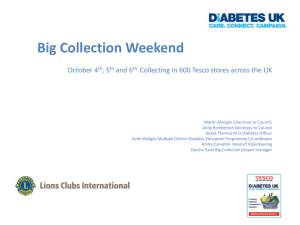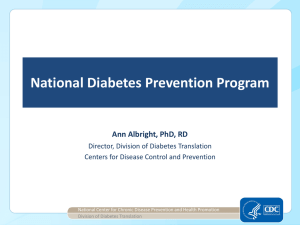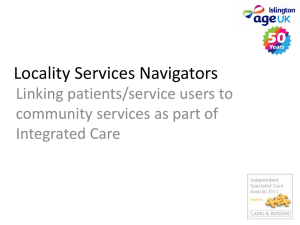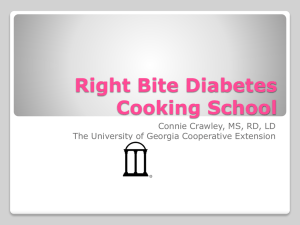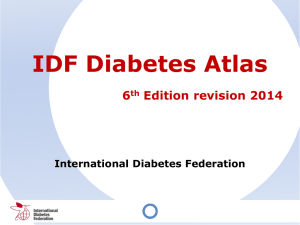DIABETES AND DEPRESSION DOUBLE THE TROUBLE
advertisement
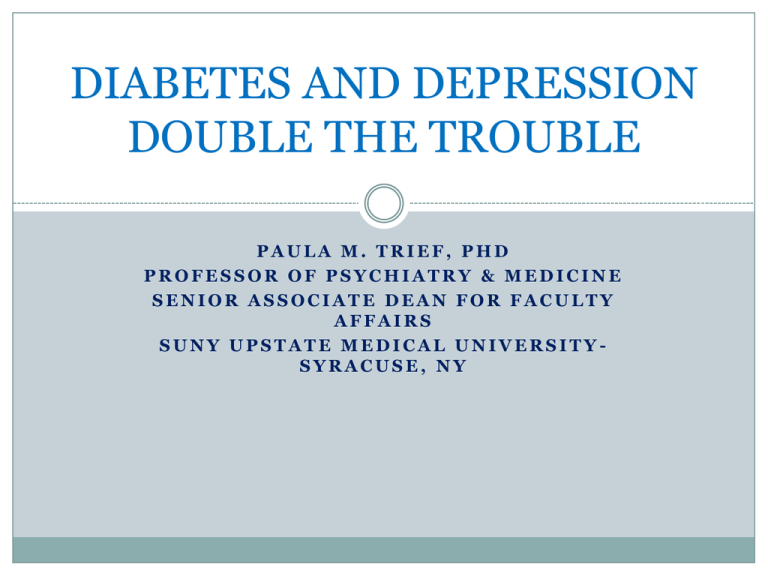
DIABETES AND DEPRESSION DOUBLE THE TROUBLE PAULA M. TRIEF, PHD PROFESSOR OF PSYCHIATRY & MEDICINE SENIOR ASSOCIATE DEAN FOR FACULTY AFFAIRS SUNY UPSTATE MEDICAL UNIVERSITYSYRACUSE, NY What is diabetes? What is depression? What are the burdens and outcomes when a patient has both disorders? What can you do to address depression in patients with diabetes? Diabetes 101: A Brief Overview of Diabetes (slides prepared by the American Diabetes Association) Diabetes in the United States • Nearly 26 million people in the U.S. have diabetes •7 million people with diabetes are undiagnosed •8.3% of the U.S. population •26.9% of U.S. residents aged 65 years and older • 1.9 million Americans aged 20 years or older were newly diagnosed with diabetes in 2010 • Every 17 seconds, someone is diagnosed with diabetes Source: National Diabetes Fact Sheet, 2011 What Happens When We Eat? After eating, most food is turned into glucose, the body’s main source of energy. The pancreas produces insulin that “unlocks” the cells to allow glucose to enter them. Normal Blood Glucose Control In people without diabetes, glucose stays in a healthy range because Insulin is released at the right times and in the right amounts Insulin helps glucose enter cells High Blood Glucose (Hyperglycemia) In diabetes, blood glucose builds up for several possible reasons… Liver releases Too little too much insulin is glucose made Cells can’t use insulin wellinsulin resistance Hyperglycemia Can Cause Serious Long-Term Problems Chronic complications of diabetes •Blindness •Kidney disease •Nerve damage •Amputation •Heart attack/disease •Stroke •Cognitive decline Burden of Diabetes in the United States •The leading cause of: •new blindness among adults •kidney failure •non-traumatic lower-limb amputations •Increases the risk of heart attack and stroke by 2-4 fold •7th leading cause of death •Mortality rates 2-4 times greater than non-diabetic people of the same age Source: Centers for Disease Control and Prevention Two Main Types of Diabetes Type 1 diabetes (~10%) Pancreas makes too little or no insulin Type 2 diabetes (~90%) •Cells do not use insulin well (insulin resistance) •Ability of pancreas to make insulin decreases over time Type 1 Diabetes • 1 in 20 people with diabetes have type 1. • Most people are under age 20 when diagnosed. • Body can no longer make insulin. • Insulin is always needed for treatment- multiple daily injections or pump. Type 2 Diabetes •Most people with diabetes have type 2. •Most people are over age 40 when diagnosed, but type 2 is becoming more common younger adults, children and teens. •Type 2 is more likely in people who: •Are overweight or obese •Are non-Caucasian •Have a family history of type 2 Treatment for Type 2 Diabetes May Change Over a Lifetime Always Includes: •Education •Healthy eating •Blood glucose monitoring •Physical Activity Will include: •Medications, including insulin Obesity* Trends Among U.S. Adults - BRFSS, 1991 (*BMI ≥ 30, or ~ 30 lbs overweight for 5’4” person) No Data <10% 10%–14% 15%–19% Obesity* Trends Among U.S. Adults - BRFSS, 1994 (*BMI ≥ 30, or ~ 30 lbs overweight for 5’4” person) No Data <10% 10%–14% 15%–19% Obesity* Trends Among U.S. Adults - BRFSS, 2000 (*BMI ≥ 30, or ~ 30 lbs overweight for 5’4” person) No Data <10% 10%–14% 15%–19% ≥20% Obesity* Trends Among U.S. Adults - BRFSS, 2006 (*BMI ≥ 30, or ~ 30 lbs overweight for 5’4” person) 15%–19% 20%–24% 25%–29% ≥30% Diabetes Trends Among U.S. Adults (Includes Gestational Diabetes) BRFSS, 1990, 1995 and 2001 1990 1995 2001 Source: Behavioral Risk Factor Surveillance System, CDC No Data <4% 4%-6% 6%-8% 8%-10% >10% Is There Any Good News? •Yes, we can reduce the chances of developing type 2 diabetes in high-risk people (weight loss, exercise, medications). •Yes, we can reduce the chances of developing diabetes complications through: •Blood glucose control (diet, monitoring, medication) •Blood pressure control •Cholesterol control •Regular visits to healthcare providers •Early detection and treatment of complications Diabetes is unique among chronic illnesses in the degree that patient behavior influences disease course and outcomes. WHAT IS DEPRESSION???? Depression includes several diagnoses Major Depressive Disorder: Diagnostic Criteria 5 of following symptoms, must include one of first two, occurred almost every day for two weeks Depressed mood Anhedonia- Loss of pleasure or interest Appetite changes- more/less Sleep disturbance- too much or too little Agitation or retardation Fatigue, less energy Feelings of worthlessness or guilt Difficulty concentrating or deciding Recurrent thoughts of death Major Depressive Disorder Depression Statistics 14.8 million American adults(6.7% incidence) Lifetime risk = 17% Leading cause of disability in Americans aged 15-44 years Men: women = 1:2 Minorities > whites 50% recurrence rate 12% become chronically depressed Increased Risk of Depression Losses (divorced) Stressful life events- poor, less education, unemployed Lack of social support (lives alone) Physical illness Familial factors Genetic factors Depression Treatment of Depression Medications- work (40% placebo vs. 60% meds), but not for 40-50% of patients No evidence that one med is better than another, trial and error Psychotherapy- works, but not for 40-50% No evidence that one therapy is better than another, choice depends on the therapist Psychotherapy + meds better than either one alone for moderate chronic/severe depression Collaborative Primary Care for Depression Two core components: - care managers: -to educate patients about depression -close patient follow-up to promote adherence to meds/therapy -encourage increased medical visits if needed - back-up psychiatrist to supervise care managers and support providers Collaborative Primary Care for Depression Gilbody et al., Arch Int Med, 2007 - meta-analysis of 37 RCTs - N= 12,355 pts. - Collaborative Care vs. primary care - CC -> 2X greater adherence to anti-deps. - CC -> improved depression @ 12 and 18 month follow-up and @ 5 years (1 trial) DIABETES and DEPRESSION: DOUBLE the TROUBLE Depression and Diabetes-Prevalence Major depressive disorder --9.3% people with diabetes vs. --6.1% in general population Clinical Depression lifetime prevalence: Men: Women: Medical Outpatients: Diabetes patients: 5-12% 9-26% 6-26% 24-33% Egede 2003; Anderson et al, 2001; Fisher 2010 Depression, Diabetes and Distress It’s not always Major DepressionDepressive symptoms are common: 31-45% of diabetes patients report significant depressive symptoms Importance of “Diabetes Distress”Evidence that diabetes distress is related to high A1c is stronger than evidence that depression is. Severity of Depression in Diabetes Natural course is chronic/severe. Depressive episodes may last longer. Depression in diabetes may be more resistant to treatment. Kovacs et al, 1997 Depression and Diabetes Outcomes Depression in diabetes is associated with: Higher A1c levels, i.e., poorer blood sugar control CVD risk factors (hi BP, hi BMI, smoking) More complications Less active self-care Higher mortality rates 3.5x higher health care costs Ciechanowski 2000, 2003;Lustman 2000;de Groot 2001;Zhang 2005, Katon 2005; Egede 2002; Rubin 2010 Why do individuals with diabetes get depressed? Possible biological factors – – changes in brain chemicals and/or hormones associated with both diabetes and depression? – chronic high or low (or variable) blood sugar levels may depression? Psychosocial “Burden” of Diabetes N= 4747, Utrecht Health Project: - normal - pre-diabetes - diagnosed with type 2 diabetes - not yet diagnosed, but found to have type 2 diabetes Results: Diagnosed type 2 diabetes associated with depression, but undiagnosed and pre-diabetes were not. Implication: Relationship between diabetes and depression may reflect the psychosocial burden of the disease. Knol et al, Psychosom Med, 2007 Depression <-> Diabetes- Bi-directional Depression Brain chemicals Hormones Behavior Diabetes/ High blood sugar Why do individuals with diabetes get depressed/distressed? Challenges > Resources Psychological challenges of diabetes Need for careful control of basic activity (eating) loss of autonomy & sense of control over body Diabetes is a hidden disease low support Stigma shame hiding (e.g., keep blood sugar levels high to avoid hypoglycemia) Why do individuals with diabetes get depressed/distressed? Psychological challenges of diabetes guilt, need to “be good,” “it’s my fault” anxiety about future complications when first complication hits: -well-controlled feel betrayed -poorly-controlled feel guilty Why do individuals with diabetes get depressed/distressed? Psychological challenges of diabetes role changes – within family, at work effect of complications, e.g., dialysis, impaired vision, impotence pain, disability/functional impairment Why don’t all individuals with diabetes get depressed/distressed? Psychological resources life environments, stress - other health problems - family health - work stability - financially secure - health insurance Psychological Resources Ways of coping Positive: Gather information, educate yourself Seek support Make a spiritual connection Exercise Negative: Denial Avoidance Alcohol, drugs Psychological Resources Sense of Self-Efficacy- “I can do it!” - Overall self-efficacy-attitude towards problems - Specific self-efficacyexercise self-efficacy diet self-efficacy Psychological Resources Social Support - Different types of support - Importance of a “confidante” Psychological Resources Self Esteem Do I like myself? Am I worth taking care of? Treatment of Depression for Diabetes Patients Medications Psychotherapy Education Family involvement Exercise Depression Management and Diabetes Outcomes Treatment of depression works for diabetes patients, as it does for others. Limited evidence that treatment of depression leads to better blood glucose control or better adherence to self-care regimen. SUMMARY 1. PREVALENCE. Depression and diabetes often occur together. 2. SEVERITY. Depression in patients with diabetes may be more severe, i.e., more likely to recur, lasts longer 3. DIABETES can make DEPRESSION worse, either due to biology, emotional burden, or both. SUMMARY 4. DEPRESSION can make DIABETES worse, i.e., poorer self-care and blood sugar control -> complications, hospitalizations and higher health care costs. 5. TREATING DEPRESSION WORKS, but more effective treatments are needed. SUMMARY 6. TREATING DEPRESSION MAY HELP BLOOD SUGAR CONTROL, but even if it doesn’t, it’s the right thing to do. 7. DIABETES DISTRESS is also important to address. 8. FAMILY MEMBERS can also get depressed, anxious, guilty and distressed. A Conversation What can you do in your role as care manager about depression for your diabetes patients? What are the barriers you experience when you try to help your patients? What can you do about depression in your diabetes patients? 1. MAKE EVERY VISIT THERAPEUTIC a. “There is no greater loan than a sympathetic ear." - Frank Tyger, cartoonist, columnist and humorist b. Close follow-up to promote adherence to meds/therapy 2. HELP PATIENTS BUILD STRENGTHS! Educate, educate, educate- make depression-diabetes link Help them find ways to cope positively. Help them reach out to others. Help them tell themselves they can do it, by establishing realistic goals, supporting small steps, praising all achievements, and believing they can. Help them tell themselves they’re worth it, by believing they are. 3. IF CHALLENGES ARE TOO GREAT, HELP PATIENTS GET HELP! Thank you for your insights and attention!!


